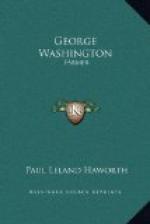Washington also raised chickens, turkeys, swans, ducks, geese and various other birds and beasts. In 1788 Gouverneur Morris sent him two Chinese pigs and with them “a pair of Chinese geese, which are really the foolishest geese I ever beheld; for they choose all times for setting but in the spring, and one of them is even now [November] actually engaged in that business.” Of some golden pheasants that had been brought from China the General said that before seeing the birds he had considered that pictures of them must be “only works of fancy, but now I find them to be only Portraits.”
The fact is that his friends and admirers sent him so many feathered or furred creatures that toward the end of his life he was the proprietor of a considerable zoo.
Notwithstanding mismanagement by his employees and slaves, Washington accumulated much valuable domestic stock. In his will, made the year of his death, he lists the following: “1 Covering horse, 5 Cob. horses—4 Riding do—Six brood mares—20 working horses and mares,—2 Covering jacks & 3 young ones 10 she asses—42 working mules—15 younger ones. 329 head of horned cattle. 640 head of Sheep, and the large stock of hogs, the precise number unknown.” He further states that his manager believes the stock worth seven thousand pounds, but he conservatively sets it down at fifteen thousand six hundred fifty-three dollars.
CHAPTER X
THE HORTICULTURIST AND LANDSCAPE GARDENER
Washington’s work as a horticulturist prior to the educating influences of the Revolution was mostly utilitarian. That he had a peach orchard as early as 1760 is proven by an entry in his diary for February 22: “Laid in part, the Worm of a fence round the Peach orchard.” Just where this orchard stood I am not quite certain, but it was probably on the slope near the old tomb.
He learned how to propagate and “wed” his own trees and in 1763 was particularly active. On March 21st he recorded that he had “Grafted 40 cherries, viz 12 Bullock Hearts, 18 very fine May Cherry, 10 Coronation. Also grafted 12 Magnum Bonum Plums. Also planted 4 Nuts of the Mediterranean Pame in the Pen where the Chestnut grows—sticks by East. Note, the Cherrys and Plums came from Collo. Masons Nuts from Mr. Gr[een’s.] Set out 55 cuttings of the Madeira Grape.”
A little later he grafted quinces on pear and apple stocks; also he grafted “Spanish pairs,” “Butter pears,” “Bergamy Pears,” “Newtown Pippins,” “43 of the Maryland Red Strick,” etc., and transplanted thirty-five young crab scions. These scions he obtained by planting the pumice of wild crab apples from which cider had been made. They were supposed to make hardier stocks than those grown from ordinary seeds.
He grafted many cherries, plums, etc., in March, 1764, and yet again in the spring of 1765, when he put English mulberry scions on wild mulberry stocks. In that year “Peter Green came to me a Gardener.” In 1768 and 1771 he planted grapes in the inclosure below the vegetable garden and in March, 1775, he again grafted cherries and also planted peach seeds and seeds of the “Mississippi nut” or pecan.




